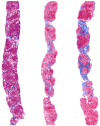Evolution of hepatic steatosis in patients with advanced hepatitis C: results from the hepatitis C antiviral long-term treatment against cirrhosis (HALT-C) trial
- PMID: 19291787
- PMCID: PMC2692566
- DOI: 10.1002/hep.22865
Evolution of hepatic steatosis in patients with advanced hepatitis C: results from the hepatitis C antiviral long-term treatment against cirrhosis (HALT-C) trial
Abstract
Hepatic steatosis is a common histologic feature in patients with chronic hepatitis C (CHC) but there are no large longitudinal studies describing the progression of steatosis in CHC. We examined changes in steatosis on serial biopsies among CHC patients participating in the Hepatitis C Antiviral Long-term Treatment against Cirrhosis (HALT-C) Trial. All 1050 patients in the trial had advanced fibrosis at baseline biopsy and were documented not to have had a sustained virological response to peginterferon and ribavirin. Most (94%) patients had genotype 1 infection. At least one protocol follow-up biopsy was read on 892 patients, and 699 had the last biopsy performed 3.5 years after randomization. At enrollment, 39% had cirrhosis and 61% had bridging fibrosis; 18%, 41%, 31%, and 10% had steatosis scores of 0, 1, 2, and 3 or 4, respectively. The mean steatosis score decreased in the follow-up biopsies in both the interferon-treated patients and controls with no effect of treatment assignment (P = 0.66). A decrease in steatosis score by > or =1 point was observed in 30% of patients and was associated with both progression to cirrhosis and continued presence of cirrhosis (P = 0.02). Compared to patients without a decrease in steatosis, those with a decrease in steatosis had worse metabolic parameters at enrollment, and were more likely to have a decrease in alcohol intake, improvement in metabolic parameters, and worsening liver disease (cirrhosis, esophageal varices, and deterioration in liver function).
Conclusion: Serial biopsies demonstrated that in patients with CHC, steatosis recedes during progression from advanced fibrosis to cirrhosis. Decreased alcohol intake and improved metabolic parameters are associated with a decline in steatosis and may modulate hepatitis C progression.
Trial registration: ClinicalTrials.gov NCT00006164.
Figures



References
-
- Lonardo A, Loria P, Adinolfi LE, Carulli N, Ruggiero G. Hepatitis C and steatosis: a reappraisal. J Viral Hepat. 2006;13:73–80. - PubMed
-
- Negro F. Steatosis in chronic hepatitis C: friend or foe? Liver Int. 2008;28:294–6. - PubMed
-
- Leandro G, Mangia A, Hui J, Fabris P, Rubbia-Brandt L, Colloredo G, Adinolfi LE, Asselah T, Jonsson JR, Smedile A, Terrault N, Pazienza V, Giordani MT, Giostra E, Sonzogni A, Ruggiero G, Marcellin P, Powell EE, George J, Negro F. Relationship between steatosis, inflammation, and fibrosis in chronic hepatitis C: a meta-analysis of individual patient data. Gastroenterology. 2006;130:1636–42. - PubMed
-
- Lok AS, Everhart JE, Chung RT, Padmanabhan L, Greenson JK, Shiffman ML, Everson GT, Lindsay KL, Bonkovsky HL, Di Bisceglie AM, Lee WM, Morgan TR, Ghany MG, Morishima C. Hepatic steatosis in hepatitis C: comparison of diabetic and nondiabetic patients in the hepatitis C antiviral long-term treatment against cirrhosis trial. Clin Gastroenterol Hepatol. 2007;5:245–54. - PubMed
-
- Lee WM, Dienstag JL, Lindsay KL, Lok AS, Bonkovsky HL, Shiffman ML, Everson GT, Di Bisceglie AM, Morgan TR, Ghany MG, Morishima C, Wright EC, Everhart JE. Evolution of the HALT-C Trial: pegylated interferon as maintenance therapy for chronic hepatitis C in previous interferon nonresponders. Control Clin Trials. 2004;25:472–92. - PubMed
Publication types
MeSH terms
Substances
Associated data
Grants and funding
- N01-DK-9-2325/DK/NIDDK NIH HHS/United States
- M01RR-00042/RR/NCRR NIH HHS/United States
- M01RR-00051/RR/NCRR NIH HHS/United States
- N01-DK-9-2321/DK/NIDDK NIH HHS/United States
- N01-DK-9-2320/DK/NIDDK NIH HHS/United States
- M01 RR000633/RR/NCRR NIH HHS/United States
- M01 RR000065/RR/NCRR NIH HHS/United States
- N01-DK-9-2322/DK/NIDDK NIH HHS/United States
- M01 RR000043/RR/NCRR NIH HHS/United States
- N01-DK-9-2323/DK/NIDDK NIH HHS/United States
- M01 RR000042/RR/NCRR NIH HHS/United States
- M01 RR000827/RR/NCRR NIH HHS/United States
- M01RR-00065/RR/NCRR NIH HHS/United States
- N01-DK-9-2328/DK/NIDDK NIH HHS/United States
- N01-DK-9-2318/DK/NIDDK NIH HHS/United States
- N01-DK-9-2324/DK/NIDDK NIH HHS/United States
- P30 DK092926/DK/NIDDK NIH HHS/United States
- N01-DK-9-2319/DK/NIDDK NIH HHS/United States
- M01RR-00827/RR/NCRR NIH HHS/United States
- N01-DK-9-2327/DK/NIDDK NIH HHS/United States
- M01RR-01066/RR/NCRR NIH HHS/United States
- M01 RR006192/RR/NCRR NIH HHS/United States
- N01 DK092323/DK/NIDDK NIH HHS/United States
- P60 DK020572/DK/NIDDK NIH HHS/United States
- M01 RR001066/RR/NCRR NIH HHS/United States
- M01 RR000051/RR/NCRR NIH HHS/United States
- N01-DK-9-2326/DK/NIDDK NIH HHS/United States
- M01RR-00633/RR/NCRR NIH HHS/United States
- M01RR-00043/RR/NCRR NIH HHS/United States
- M01RR-06192/RR/NCRR NIH HHS/United States
LinkOut - more resources
Full Text Sources
Other Literature Sources
Medical
Molecular Biology Databases
